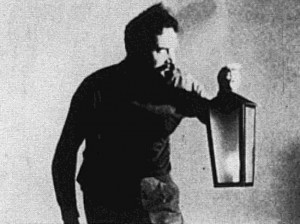"The Black Cat is a 25-minute version of Edgar Allen Poe's story by the same name and concerns a man who does away with his wife in what he believes to be the perfect crime, only to be outdone in the end by the family black cat. This low key, well dramatized version is the only 8mm film among the top ten and also received the MPD Scenario Film Award" PSA Journal, Sept. 1965, 50.

"a soggetto breve"/short fiction based on the eponymous novel by Edgar Allan Poe

From the eponymous novella by Edgar Allan Poe
"II cuore rivelatore, realizzato da Alberto Mondadori, collaboratore Mario Monicelli, scenografia di Alberto Lattuada, operatore Cesare Civita; da un racconto di Edgar Allan Poe. lnterpreti Giuseppe Pedrini, Giuliano Carta. Abbiamo accennato tempo fa ad un film sperimentale americano sullo stesso soggetto, dovuto a R. P. Cobb. Interessante appare iI confronto con questo di Mondadori; in definitiva quello appare più surrealista, questo e invece più incisivo e reale preoccupandosi piuttosto Mondadori di creare l'atmosfera allucinata con uso non eccessivo di puri espedienti tecnici; ne consegue una maggior chiarezza nel racconto cinematografico, che procede abbastanza sostenuto anche per la buona interpretazione. Il regista non ha rinunciato tuttavia a quegli espedienti tecnici, come sovrimpressioni, ma ne ha usato in modo conveniente, senza esagerazioni . E' infine da tener presente l'intendimento di tentare nel campo della produzione italiana a passo ridotto, un genere diverso da i consueti."
"II cuore rivelatore (The Tell-Tale Heart), directed by Alberto Mondadori, with the collaboration of Mario Monicelli, set design by Alberto Lattuada, cameraman Cesare Civita, based on a story by Edgar Allan Poe. Some time ago, we mentioned to an American experimental film on the same subject by R. P. Cobb. Comparing it with this of Mondadori proves interesting; ultimately, that one appears more surrealist, while this one is instead more incisive and real since Mondadori concerns himself with creating the hallucinated atmosphere through a not excessive use of pure technical expedients; a greater clarity in the cinematographic story follows, which moves forward in a sustained enough fashion also for the good acting. The director has not abandoned himself to those technical expedients, such as superimpositions, but he has used them in a suitable way, without exaggerations. It is important, finally, to keep in mind the intention to try in the field of small-guage Italian production, a different genre from the usual."
—Il Ventuno 28 (Review of the G.U.F. of Venice), May 1935

"The Fall of the House of Usher" not only represents a new cinema technique but it is also unique in that it does not attempt to tell Poe's story in detail, rather to invoke in its audiences the esthetic impressions and moods which the tale creates in its readers. This revolutionary approach to the cinema opens a fascinating field for further pioneering. Fortified with the new scientific instruments which have recently been devised for the detection and recording of emotional reactions, the amateur producer may now truly be said to face a new world for cinematic experimentation in translating such reactions into film. Properly motivated by medical authority films of this nature may even prove to have a tremendous psychological significance. From any viewpoint "The Fall of the House of Usher" represents a forecast of possibilities which are amazing." Movie Makers, January 1929, 847.
"Undoubtedly a great deal of time and effort went into this production. An ambitious undertaking, complete with specially designed costumes and props. Excellent lighting." PSA Journal, Dec. 1955, 37.

"We have the creation of an audiovisual of Edgar Allen Poe's classic. Mr. Cowel's picture interpretation gives the dimension of life to Mr. Poe's terrifying drama. A prisoner of the Spanish Inquisition at Toledo, in a dark dungeon, describes his horrible tortures" PSA Journal, Oct. 1961, 48.

"In a setting of props prepared for the purpose and with the aid of makeup, Albert Bahcall has filmed the Tell-Tale Heart, adapted from the story by Edgar Allen Poe. The "old man" with a strong heart also has a protruding eye that annoys the manservant to a point beyond restraint. There is an effective use of color, moving feet and hands, and closeup of faces to sharpen the impact of the story" PSA Journal, Nov. 1957, 53.

"The TellTale Heart is a 1928 American silent film directed by Charles F. Klein, based on the short story by E.A. Poe. This experimental, avant-garde film used many new techniques and influenced a series of cinematic Poe renditions in both the United States and France, including The Fall of the House of Usher by M. Webber, made in the same year. The two films have many aesthetic similarities, although the narrative in The TellTale Heart is significantly less abstract. The music underscoring the work creates a parallel drama to the events unfolding on the screen. After the title sequence, some of the text from the original short story is projected to foreshadow the gruesome events to follow. A still of the Old Man's eye is layered on the top of this scrolling text, accompanied by the first statement of the “Vulture Eye Chord”, which continues to come back as a leitmotif throughout the score. Also prominent is the leitmotif for our narrator, which takes the shape of a disturbingly quick and easily unhinged "Death Waltz". Upon strangling the Old Man for his vulture eye, the waltz quickly dissolves into a quick 5/8 section, dignifying the beating of a heart, which gradually slows. After two detectives come to investigate the scene, the narrator having initially been successful in covering up his deceit, the underscoring reveals to us that he's been tortured by his deeds as the two leitmotifs emerge from an otherwise calm texture. After hearing the beating of the Old Man's heart beneath the floorboards, the narrator admits to his sin and reveals the body at the end of the film" Center for Fiction, NY.